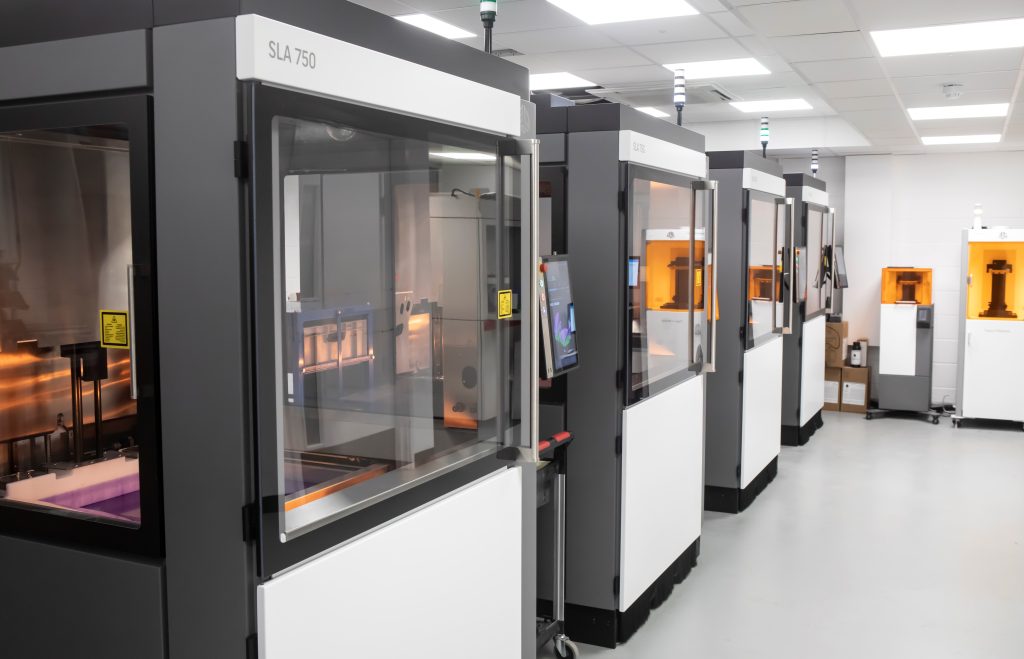U.S. based additive manufacturing company 3D Systems recently announced that BWT Alpine F1 has purchased four of its SLA 750 3D printing systems. Alpine F1 has purchased these machines to aid its production of components for wind tunnel testing, with the team already using 3D Systems’ SLA and SLS technology to print 25,000 parts annually.
The 3D printers, which use Accura Composite PIV material, are intended to help to reduce preparation time and improve performance. This is achieved by 3D printing components with high sidewall and surface quality, excellent feature detail and high geometric accuracy, thus requiring less post-processing and finishing time.
“We are very impressed with the depth of precision engineering that went into the development of 3D Systems’ SLA 750”, stated Ben Mallock, deputy head of aerodynamics at BWT Alpine F1 Team. Mallock claims that, whilst beta testing the SLA 750, the Alpine team “achieved the best part quality we have so far seen in the market with considerably improved productivity”. This success subsequently led to Alpine purchasing three further machines, bringing their current total up to four. Mallock continued, “we are enjoying the positive impact this is having on our wind tunnel testing, and getting our innovation to the track faster”.
John Murray, VP, global ISG segment & business development, 3D systems, asserts that “3D Systems has long prided itself on building solutions centered on addressing our customers’ application challenges”. Thus, Murray calls this collaboration with Alpine F1 “a testament to how we’re advancing the science of additive manufacturing to help our customers defy limitations and maintain competitive advantage”.

Using a suite of AM features to design, print and test key components
3D Systems claims that the SLA 750 has been designed to deliver a leading combination of speed, accuracy, print size and resolution for final parts. To aid in delivering this, the printer system includes 3D Systems’ all-in-one CAD to print software, 3D Sprint®. This software provides tools needed to prepare, optimize, and print 3D CAD data. This all-in-one system allows the user to go from the design stage to the production of 3D printed parts without having to use multiple software programmes. Consequently, the Alpine team has been able to streamline the development and production of its 3D printed wind tunnel testing parts.
This purchase of four SLA 750 systems is not the first time that Alpine F1 and 3D Systems have collaborated. Back in 2021, the two companies worked together to co-develop the Accura Composite PIV material. This composite resin is designed to aid in the production of wind tunnel components which are tested through a laser based technology known as Particle Image Velocimetry (PIV).
By using this specialized Accura material in conjunction with the SLA 750 and 3D Sprint software, components take significantly less time to prepare, and deliver high-resolution data which is especially accurate. For instance, 3D Systems claim that Accura material is effective in reducing the laser reflection effect, which can limit the accuracy of wind tunnel testing data when assessing the aerodynamics of 3D printed parts. Moreover, the composite PIV is alleged to possess a high tensile and flex modulus, with a heat deflection temperature of 100℃ – ideal for the rigors of extensive wind tunnel testing.
Pat Warner, advanced digital manufacturing manager at Alpine F1 Team, has praised the composite material’s “unique optical characteristics”, claiming that “we are now collecting more reliable data from our PIV system in the wind tunnel”. Similarly, Murray has expressed that “it’s incredibly rewarding to see how our latest innovation in SLA technology is combined with a material we co-developed with BWT Alpine F1 Team to accelerate design iteration and innovation for wind tunnel testing”.

The broader use of AM in F1 to optimize wind tunnel testing
F1 teams utilizing AM technology to optimize the wind tunnel testing of components is nothing new. Indeed the McLaren F1 racing team has a long-term partnership with 3D printer OEM Stratasys, dating back to 2017. In 2022, it was announced that McLaren was using five Stratasys Neo 800 3D printers to produce numerous aerodynamic parts in support of its wind tunnel testing projects. At the time, Tim Chapman, McLaren’s head of AM, declared that the Neo printers “have helped us to dramatically reduce the lead times of our aerodynamic wind tunnel components and project”. By facilitating the production of large parts, such as scale model top bodies, in as little as three days, the benefits offered by Stratasys’ AM technology are certainly clear to see.
Similarly, in 2021 Alfa Romeo Racing made extensive use of Additive Industries’ MetalFAB1 3D printer to help cut spending in car testing and development. The MetalFAB1 enabled the Alfa Romeo team to rapidly manufacture lightweight components, which cost 90% less than those produced using traditional methods. Jan Monchaux, Technical Director at Alfa Romeo, praised the Stratasys system for its cost-cutting benefits, claiming that “it helps us to achieve an important element of the cost cap”.
Subscribe to the 3D Printing Industry newsletter to ensure you keep up to date with the latest 3D printing news. You can also follow us on Twitter, like our Facebook page and subscribe to the 3D Printing Industry Youtube channel to access more exclusive content.
Are you interested in working in the additive manufacturing industry? Visit 3D Printing Jobs to view a selection of available roles and kickstart your career.
Featured image shows one of the BWT Alpine F1 Team’s cars in the pits at the Miami Formula 1 GP. Photo via the BWT Alpine F1 Team.


